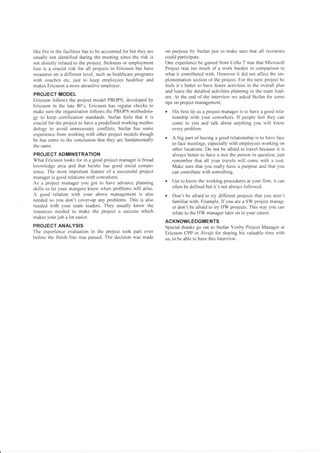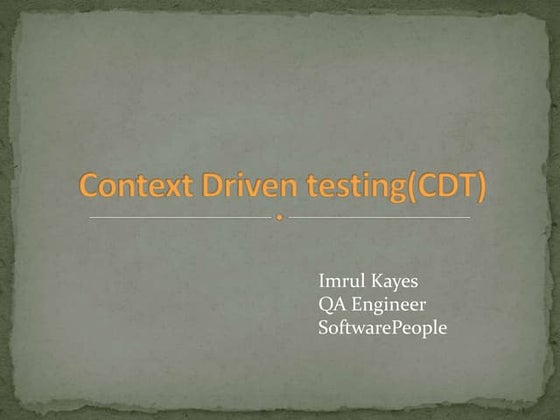Interview with Stefan
- 1. Project management Douglas lsaksson Master of Science student, Royal Institute of Technology Stockholm, Sweden douglasi@kth,se Abstract In this paper, we will discuss a proiect through the initial phases and the evaluation process from a proiect manag- er's point of view. Laying the foundationfor this article is the development of a hardware platform, the "Cello 7 project". Led by the former KTH student nowadays expe' rienced project manager at Ericsson Stefan Voxby, gladly taking the opportunity of sharing his knowledgu to the coming generation. INTRODUCTION To get a good insight of the real work of a project manager we were offered a chance to make an interview with an Ericsson employed Project manager, Mr. Stefan Voxby at Ericsson CPP (Cello Packet Platform) facilities in ├älvsjO. Stefan was assigned as a subproject manager for the "Cello 7 project" involving a total of 100 people working during the 1 year development. Figure 1. Stefan Voxby outside Ericsson CPP in Alvsj├Č PLANNING The goal of the project was to design, test and produce a new hardware board. Time was the most criti cal factor in this proj ect. Ericsson had to surpass competitors increasing quality and performance by upgrading their current hard- ware boards. Stefan was appointed the project in the planning phase and as a first stage he had to gather human resources into teams. From there the specialist from each team made an imple- mentation proposal. The proposal contains afi estimate of how much time it will take to achieve the functionality and quality needed for the product. The project manager san on Ericsson CPP Sebastian Jacobsson Master of Science sfudent, Royal Institute of Technology Stockholm, Sweden sebjac@klh.se then use this as a basis for his Project Plan. An integration plan was then created to indentiff where the project had its dependencies. Examples of this would be when the proto- type had to be delivered to the test department or when the project will get delivery from the component factory. Since this was a hardware project there were potentially a lot of practical problems. Prototyping in itself can be very problematic and that has to be accounted for in the planning stages of the project. A first for Stefan in this project was using Microsoft Project to keep track of the progress and identifying the critical line so the activities could be optimized. Each week Stefan would gather all his team leaders to get an update on the project'S progress and import that into Microsoft Project. However it is common within Ericsson that each subproject managerlteam leader can use whatever planning me- thod/tool they want fbr their part of the project as long as they follow the integration plan. Stefan encourages his team leaders to state the resources they want as a part of their team. He then goes to his Line Manager and specifies the people he wants for his project. This way he hopes that he can increase working efficiency. However exact resources are usually hard to get hold of since a lot of things can get in the way, other projects might have a higher priority allocating the first choice resources or the named resource might be unavailable due to sickness or childcare etc. There are always critical resources and it's always a task for the project management to allocate these people to the right activity. RISK MANGEMENT One important step that can be a real asset to entire proj ects is the risk handling. If managed properly it can reduce risks to avoid delays before they occur. A normal way of work- ing is the mini risk method, however other methods could be applied depending on the consequences, an example would be time based risks. It is always important to keep in mind that premier competence, risk and measures stays on the level it concerns. Working the risks up to the top level hierarchy is the 10 most crucial risks, where they can dep- loy action measures. Looking back at the Cello 7 project a risk that occuffed was component shortage. That was a risk on the hardware level thatwould delay the entire project, but was prevented using good risk measures. The process leader, in charge of the risk meeting (not nec- essarily the project manager) has to make sure the risks are weighted depending on probability and consequence. Risks
- 2. like fire in the f├żcilities has to be accounted for but they are usually not identified during the meeting since the risk is not directly related to the proj ect. Sickness or employment loss is a crucial risk for all projects in Ericsson but have measures on a different level, such as healthcare programs with coaches etc., just to keep employees healthier and makes Ericsson a more attractive employer. PROJECT MODEL Erissson follows the project model PROPS, developed by Ericsson in the late 80's. Ericsson has regular checks to make sure the organization follows the PROPS methodolo- gy to keep certification standards. Stefan feels that it is crucial for the project to have a predefined working metho- dology to avoid unnecessary conflicts. Stefan has some experience from working with other project models though he has come to the conclusion that they are fundamentally the same. PROJECT ADMINSTRATION What Ericsson looks for in a good project manager is broad knowledg. area and that he/she has good social compe- tence. The most impoftant feature of a successful project manager is good relations with coworkers. As a project manager you got to have advance planning skills to let your mangers know when problems will arise. A good relation with your above management is also needed so you don't cover-up any problems. This is also needed with your team leaders. They usually know the resources needed to make the project a success which makes your job a lot easier. PROJECT ANALYSIS The experience evaluation in the project took part even befbre the flnish line was passed. The decision was made on pupose by Stefan just to make sure that all recourses could participate. One experience he gained from Cello 7 was that Microsoft Project was too much of a work burden in comparison to what it contributed with. However it did not affect the im- plementation section of the project. For the next project he feels it's better to have fewer activities in the overall plan and leave the detailed activities planning to the team lead- ers. At the end of the interview we asked Stefan for some tips on project management. o His best tip as a project manager is to have a good rela- tionship with your coworkers. If people feel they can come to you and talk about anything you will know every problem. . A big part of having a good relationship is to have face to face meetings, especially with employees working on other locations. I)o not be afraid to travel because it is always better to have a met the person in question, just remember that all your travels will come with a cost. Make sure that you really have a purpose and that you can contribute with something. o Get to know the working procedures at your firm, it can often be defined but it's not always followed. . Don't be afraid to try different projects that you aren't familiar with. Example. If you are, a SW project manag- er don't be afraid to try HW projects. This way you can relate to the HW manager later on in your career. ACKNOWLEDGMENTS Special thanks go out to Stefan Voxby Project Manager at Ericsson CPP in ├älvsj├Č for sharing his valuable time with us, to be able to have this interview.










































